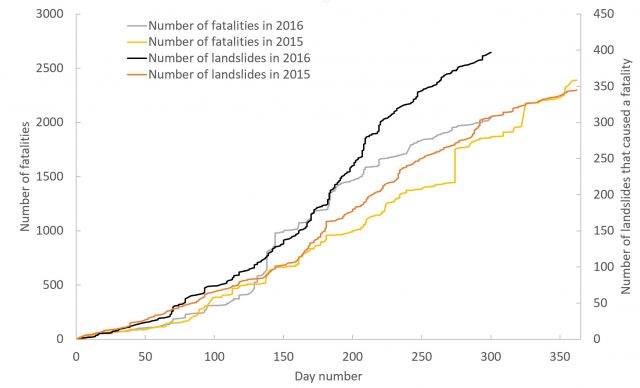7 November 2016
The 2016 landslide year to the end of October
Posted by Dave Petley
The 2016 landslide year to the end of October
A couple of months ago I reviewed the impact of landslides in 2016 to date; I thought it would be timely to provide an update on the 2016 landslide year to the end of October. I will develop this further in my talk at the landslide session at AGU in December – I believe that this is a session that will be live-streamed, so those who cannot make it will be able to tune in. The data that I am using here is based on my long term (since 2002) data on landslides that cause loss of life, as described in Petley (2012) [Contact me via the blog if you want a copy]. Note that I only collect data on landslides that kill people.
The headline is that the 2016 landslide year has been a bad year in terms of numbers of events. As of the end of October I have recorded 396 non-seismic landslides. At a similar point in 2015 I had recorded 330 landslides. However, in terms of loss of life the numbers are much more average, with 2,021 deaths in total. This reflects the lack of any really large events in the 2016 landslide year to date. Of course that can still change.
This is the cumulative graph for landslide losses to date in 2016:

The cumulative number of landslides and fatalities in the 2016 landslide year to date
.
I have added a linear best fit line for both datasets simply to emphasise the deviation from the trend. In both cases the number of landslides is low in the first part of the year, then accelerates from about day 120. The number of recorded landslides is high through the northern hemisphere summer, but from about day 210 has settled down to a rate similar to the annual average. The number of deaths is dominated by significant loss of life around day 140. Since then the rate has been similar to the annual average.
In both cases, the high rates in the northern hemisphere summer reflect an active South Asian monsoon.
By way of comparison, this is the 2016 plotted alongside that for 2015:

2016 and 2015 landslide loss data compared
.
The data suggest that the numbers of fatalities do not vary greatly between the two years to date. However, the number of recorded events in the 2016 landslide year greatly exceeds that of 2015, and indeed is now greater than for the entire year.


 Dave Petley is the Vice-Chancellor of the University of Hull in the United Kingdom. His blog provides commentary and analysis of landslide events occurring worldwide, including the landslides themselves, latest research, and conferences and meetings.
Dave Petley is the Vice-Chancellor of the University of Hull in the United Kingdom. His blog provides commentary and analysis of landslide events occurring worldwide, including the landslides themselves, latest research, and conferences and meetings.